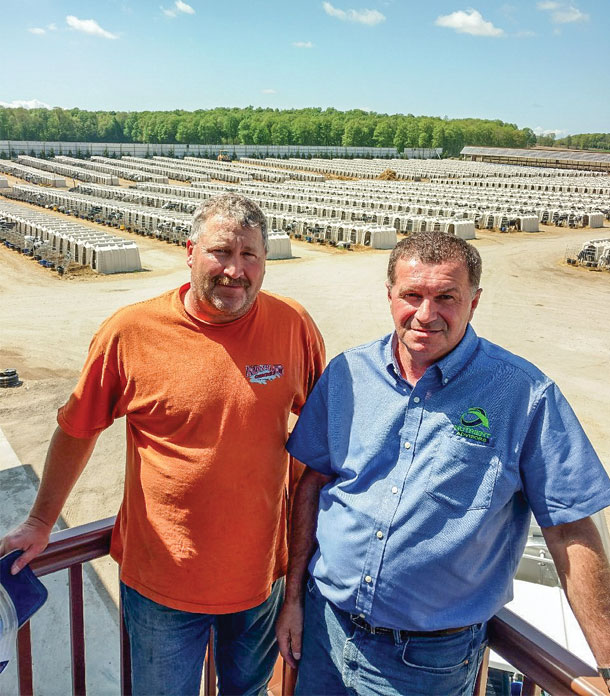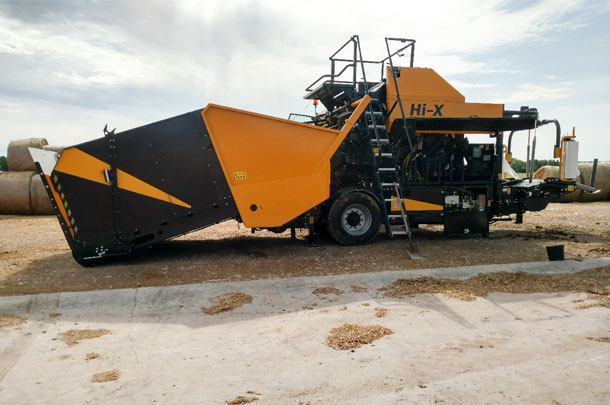J Hall started custom raising dairy calves in 1995. What began as a small venture in his backyard in Kewaunee, Wisconsin, has grown into a farm with 8,500 calves from 27 different farms and 65 full-time employees.
In focusing his efforts on raising calves, Hall works with local crop producers to supply him with feed and bedding and to dispose of the manure produced on his farm.

“I don’t own the land,” Hall says. “I buy crops from the crop farmers, and they know I have to get rid of my manure. If I don’t put it on their fields, I have to haul it farther and farther and farther away, and it costs more money.”
For years, he has been aggressively searching for and trying different ways to turn manure into an asset. His latest idea comes from overseas in a piece of equipment that will grind, chop and mix the straw-pack manure prior to tightly packing and wrapping it into a sealed plastic bale.
“We are in the process of being able to bale our manure, which sounds weird,” Hall says. However, if it works as he believes it will, this method will address the problems he is currently facing without the negative effects he found with the other manure processing options he researched.
Currently, manure is collected by scraping the pad where the outdoor hutches sit after the calves move out at 9 weeks old. The mono-slope, open-front, bedded-pack barns, where calves are kept in groups of 10 after weaning, are cleaned when the groups leave the farm at 5 months old.
All manure is loaded and hauled to a concrete pad that slopes one way to a small pit to collect all runoff from the area. The stacked manure is hauled off the farm twice a year to the fields of local crop farmers.
Hall works with Nutrient Advisors for environmental compliance, nutrient management planning and as a link between Hall and the crop farmers receiving the manure. He meets monthly with area manager Kyle Govin to discuss the farm’s environmental situation.
“We determine the value of that product agronomically as well as in comparison to commercial fertilizer to make sure that product is accurately valued and crop producers are utilizing that product the best way possible,” Govin says.
Once the baling system is in place, Govin plans to implement sampling protocols to monitor the manure processing and provide nutrient information to the crop farmers and any other potential customers.
It has taken longer than expected to import the baling machine. It recently arrived in the U.S., and Hall says he hopes to have the equipment on-farm and making bales by the middle of June.
He anticipates piling manure in a bay and running the baler twice a week, producing 200 bales each week.
By grinding the straw and manure first, the material can be densely packed. The 4x4 bales are expected to weigh between 2,000 and 3,000 pounds and will take up a smaller footprint when stored.
Since each one is sealed tight in plastic wrap, the material inside is anaerobically digested. After sitting for eight to 10 weeks, the resulting material is a product known as bokashi.
“This is still very new for us,” Hall says, noting the company said he will be the first in the U.S. with this particular system.
“I’m hoping, in the long run, it turns into a revenue, that it turns into a way of being able to take care of the problem of manure and turning it into an asset,” he continues.
Prior to this, he looked at traditional composting with different styles of turners, in-vessel composting and pulling air through the rows. Hall also tried a few composting scenarios on the farm, but he didn’t like how much space it required.
“It leaves a huge footprint,” he says. “You wind up having rows and rows of manure and of compost open to the elements, open to rain and snow.”
The plastic-wrapped bales can be stacked in multiple layers and don’t have to be on a clay or concrete pad like compost rows do, thus taking up a much smaller footprint on the farm.

When composting, large amounts of greenhouse gases are emitted from the rows, just as they are in Hall’s current method of stacking the bedded-pack manure. There won’t be any greenhouse gases emitted from the sealed bales as they sit in storage.
“We believe it’s going to be very environmentally friendly,” Hall says.
He also plans to use a lot of the runoff water collected from the farm within the baling process to maintain a product consistency of 65 percent dry matter.
“My goal is that we have nothing leaving our farm that isn’t being utilized to grow other products. I want to be able to use all of our manure and runoff as a fertilizer,” he says.
Hall intends to sell the finished product as a fertilizer to whoever wants it for their fields. It could be considered an organic fertilizer, or he says he can mix in additional products like urea, gypsum or potash during the grinding phase to create a product to meet a customer’s fertilizer needs.
In other countries, he says, the bokashi product is also used as a potting soil and as a soil amendment to help the ground absorb more moisture.
He worked with his nutrient management planners on a crude trial of tightly packing and wrapping some manure in plastic. The result was a favorable product for use in fields and for crops.
“Where exactly it is going to change the value we’ll have to really see on the comparisons as we get the first product finished out, but it’s going to make a product that’s going to break down and be utilized by the crop a little faster,” Govin says.
The digestion process will help break down the materials. In addition, by balancing the carbon-to-nitrogen ratio to ensure proper composting of the product, the nitrogen that’s in the soil will no longer be tied up to break down the straw that’s in his current manure product.
Govin says some local crop producers, who have been hesitant to take the existing pen pack manure, have already expressed interest in this new product.
Another challenge of the loose, bedded-pack manure Hall currently has is: It is very bulky. He can only load about 10 tons on a large manure spreader. With these bales, he anticipates putting five times that amount in the same spreader.
“It condenses it so we can haul it much farther away. We can haul it on fields that need it, on sandier soils, and we can put it on places that otherwise you wouldn’t be able to put conventional manure on,” Hall says.
Govin says having a product of this nature that is logistically friendly will be very beneficial, especially in the region where Hall farms.
The northeast corridor of Wisconsin is heavily impacted by shallow bedrock and karst soils.
“Some of the acres that may have historically been receiving liquid dairy manure from one of the other dairies in the area may no longer be able to do so because of the new restrictions limiting the use of liquid manure on karst soils, but they will be able to utilize this product on those acres,” Govin says.
This baled product will be a fit in those areas locally and then the market can be expanded to benefit other producers outside of the local area. The sealed dense bales can be loaded on semi-trailers and hauled wherever the product is wanted.
“It can be hauled 500 miles away and still be economically the right thing to do,” Hall says.
Hall is also considering taking in products like yard waste, which can be broken down through this process. Municipalities are using this same system to bale leaves, grass clippings, cardboard and food waste. He plans on building a structure, similar to a commodity shed, with different bays to store various input products.
The trick will be finding the right “recipe” to process these materials into the type of fertilizer or product a consumer wants.
As strange as baling manure may sound, this new process addresses many of the challenges Hall has with the bedded-pack manure on his calf operation. Once up and running, he will be able to better analyze the resulting product and work to build a revenue stream from what has been a waste product on his farm.
“We’ve done enough research on composting and digesting I do believe this is the answer for our facility. It’s just how we utilize it and how quickly we create a market for it that has yet to be seen,” Hall says. ![]()
PHOTO 1: Photo provided by Dan Guenther.
PHOTO 2: With little to no land for manure application, J Hall (left) has been aggressively searching for a way to turn manure waste from his custom calf-raising operation into revenue. In June, he hopes to start using a new piece of equipment that will bale and seal the manure to digest the material. Hall has been working with Dan Guenther (right) and Kyle Govin (not pictured) from Nutrient Advisors to manage his farm’s nutrients and analyze the value this new fertilizer product could bring to his farm. Courtesy photo.
PHOTO 3: Photo provided by Dan Guenther.
VIDEO: Video courtesy of Hall's Calf Ranch.

-
Karen Lee
- Editor
- Progressive Dairyman
- Email Karen Lee






